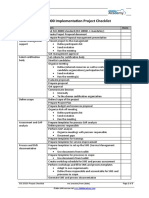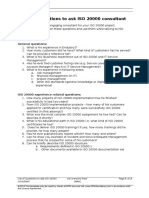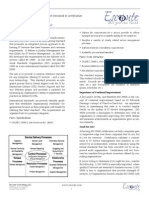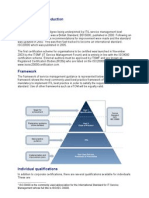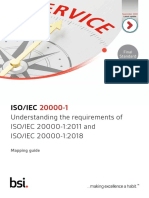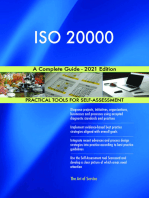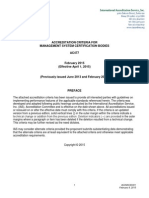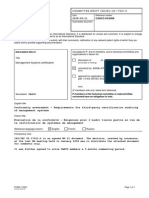100%(1)100% found this document useful (1 vote)
1K viewsDocuments For ISO 20000
Documents For ISO 20000
Uploaded by
Usman HamidThis document outlines the key policies, plans, procedures, definitions, documents and records required by the ISO/IEC 20000 standard for an effective Service Management System (SMS). It includes requirements for policies on service management, continual improvement, information security and change/release management. Plans are needed for service management, continuity, availability, capacity and audits. Procedures are specified for communication, document control, incident/problem/change management and more. Definitions, service requirements, SLAs, reports and security controls are also documented. Records provide evidence of conformity to the standard.
Copyright:
© All Rights Reserved
Available Formats
Download as DOCX, PDF, TXT or read online from Scribd
Documents For ISO 20000
Documents For ISO 20000
Uploaded by
Usman Hamid100%(1)100% found this document useful (1 vote)
1K views3 pagesThis document outlines the key policies, plans, procedures, definitions, documents and records required by the ISO/IEC 20000 standard for an effective Service Management System (SMS). It includes requirements for policies on service management, continual improvement, information security and change/release management. Plans are needed for service management, continuity, availability, capacity and audits. Procedures are specified for communication, document control, incident/problem/change management and more. Definitions, service requirements, SLAs, reports and security controls are also documented. Records provide evidence of conformity to the standard.
Original Description:
Documents required for ISO 20000/ ITSM
Original Title
Documents for ISO 20000
Copyright
© © All Rights Reserved
Available Formats
DOCX, PDF, TXT or read online from Scribd
Share this document
Did you find this document useful?
Is this content inappropriate?
This document outlines the key policies, plans, procedures, definitions, documents and records required by the ISO/IEC 20000 standard for an effective Service Management System (SMS). It includes requirements for policies on service management, continual improvement, information security and change/release management. Plans are needed for service management, continuity, availability, capacity and audits. Procedures are specified for communication, document control, incident/problem/change management and more. Definitions, service requirements, SLAs, reports and security controls are also documented. Records provide evidence of conformity to the standard.
Copyright:
© All Rights Reserved
Available Formats
Download as DOCX, PDF, TXT or read online from Scribd
Download as docx, pdf, or txt
100%(1)100% found this document useful (1 vote)
1K views3 pagesDocuments For ISO 20000
Documents For ISO 20000
Uploaded by
Usman HamidThis document outlines the key policies, plans, procedures, definitions, documents and records required by the ISO/IEC 20000 standard for an effective Service Management System (SMS). It includes requirements for policies on service management, continual improvement, information security and change/release management. Plans are needed for service management, continuity, availability, capacity and audits. Procedures are specified for communication, document control, incident/problem/change management and more. Definitions, service requirements, SLAs, reports and security controls are also documented. Records provide evidence of conformity to the standard.
Copyright:
© All Rights Reserved
Available Formats
Download as DOCX, PDF, TXT or read online from Scribd
Download as docx, pdf, or txt
You are on page 1of 3
Policies
Service management policy (4.1.1, 4.1.2)
Policy on continual improvement of the SMS and the services (4.5.5.1)
Budgeting and accounting policies (6.4)
Information security policy (6.6)
Change management policy (9.2)
Release management policy (9.3)
Plans
Service management plan (4.1.1, 4.5.2)
Service continuity plan (6.3.2)
Availability plan (6.3.2)
Capacity plan (6.5)
Objectives of internal audits and management reviews (4.5.4.1)
Audit program (4.5.5.2
Plan to implement an improvement (4.5.5.2)
New or changed service plan (5.2) [for removal of service, a removal plan]
Release plan (9.3)
Procedures
Clause 4.3.1 requires documented service management processes. The required processes are
those in Clauses 5 to 9. There are also processes in clause 4 which require a documented
description e.g. resource management, documentation management.
Clause 4.3.1 also requires documented procedures required by this part of ISO/IEC 20000. The
required procedures are:
Communication procedures
Control of documents
Control of records
Internal audit procedure planning and conducting internal audits
Management of improvements
Procedures to be used for the delivery of new or changed services
Procedures to support the budgeting and accounting for services process
Procedures to be implemented in the event of a major loss of service as part of the service
continuity plan
Procedures to enable predictive analysis of capacity
Managing service complaints
Managing contractual disputes
Incident management procedure managing incidents from recording to closure, managing
major incidents
Managing the fulfillment of service requests from recording to closure
Problem management procedure identifying problems and minimizing or avoiding the impact
of incidents and problems
Configuration management procedure recording, controlling and tracking configuration items
Change request procedure recording, classifying, assessing and approving requests for change
Emergency change request procedure managing emergency changes
Managing emergency release procedure
Definitions
There are a few documented definitions required. These are as follows:
Service complaint (7.1), this is often defined in the SLA
Major incident (8.1), this is often defined in the SLA
Types of CI (9.1), this is usually defined in the configuration management process
Other Key Documents
Service requirements (4.1.4)
Catalogue of services (4.3.1, 6.1)
Service level agreements (4.3.2, 6.1)
Documented agreements (6.1), This applies specifically to agreements between internal groups
or customers acting as suppliers that are providing some service components or operating a
process or part of a process. These can be known as operational level agreements (OLAs)
Description of each service report, including its identity, purpose, audience, frequency and
details of the data source(s) (6.2)
Risks to service continuity and availability of services (6.3.1)
Opportunities for improvement, including corrective and preventive actions (4.5.5.1)
Design of new or changed services (5.3) for each new or changed service
Information security controls including the risks to which they relate (6.6.2) and those controls
for external organizations (6.6.3)
Customers, users and interested parties of the services (7.1)
Supplier contracts (7.2)
Roles of, and relationships between, lead and sub-contracted suppliers (7.2)
Records
Records are required to enable control and provide evidence of conformity to the requirements of the
standard (4.3.1). Records can be paper based or kept on tools. Examples of records are minutes of
management review meetings, incident records on a service desk tool and service reports.
Other possible documents
Clause 4.3.1 also refers to additional documents, including those of external origin, determined by the
service provider as necessary to ensure effective operation of the SMS and delivery of the services.
Examples of such documents are user manuals from a software tool vendor or the ISO/IEC 20000
standard itself.
You might also like
- Checklist ISO 20000-2018Document113 pagesChecklist ISO 20000-2018roswan88% (8)
- ISO27k ISMS Scope ExamplesDocument1 pageISO27k ISMS Scope ExamplesUsman Hamid67% (3)
- COBIT 4 To 5 MappingDocument22 pagesCOBIT 4 To 5 MappingSigula Galuh100% (2)
- ISO 20000-1 Gap Analysis QuestionaireDocument15 pagesISO 20000-1 Gap Analysis QuestionaireUsman Hamid67% (6)
- ISO 20000 Requirements by Type (Blank Template)Document13 pagesISO 20000 Requirements by Type (Blank Template)abdelmutalabNo ratings yet
- Risk Assessment and Risk Treatment MethodologyDocument4 pagesRisk Assessment and Risk Treatment MethodologyAhmad Nawaz100% (1)
- ITIL Edition 2011 - COBIT 5 - Mapping Glenfis AG v1.2Document1 pageITIL Edition 2011 - COBIT 5 - Mapping Glenfis AG v1.2otnawrupNo ratings yet
- Summer Internship Project (Amul India)Document62 pagesSummer Internship Project (Amul India)Yajurv Atmapujya87% (45)
- Iso 27002 - Iso 27017 - Iso 27018 - Iso 27701 MappingDocument1 pageIso 27002 - Iso 27017 - Iso 27018 - Iso 27701 MappingsergioNo ratings yet
- Apple Math LessonDocument12 pagesApple Math Lessonapi-495904597No ratings yet
- ISO 20000 Implementation Project ChecklistDocument3 pagesISO 20000 Implementation Project Checklistmilad4556No ratings yet
- ISO 20000 (Service Management)Document4 pagesISO 20000 (Service Management)billmin1110% (1)
- ISO-20000 - Checklist For A ConsultantDocument2 pagesISO-20000 - Checklist For A Consultantamnesia2001No ratings yet
- ISO 20000 Requirements by Process (Blank Template)Document1 pageISO 20000 Requirements by Process (Blank Template)muertasencilla100% (5)
- COBIT 2019 - ISO 27001 (2013 - 14 - 15) CrossoverDocument66 pagesCOBIT 2019 - ISO 27001 (2013 - 14 - 15) CrossoverYanto100% (2)
- IC ISO 27001 Internal Audit Schedule 10838Document3 pagesIC ISO 27001 Internal Audit Schedule 10838Mbang Abdoul KaderNo ratings yet
- ISO/IEC 20000: An Introduction to the global standard for service managementFrom EverandISO/IEC 20000: An Introduction to the global standard for service managementNo ratings yet
- Day 1 Approx. Time Scope / Activity To Be Assessed Auditor / Team Member(s) InvolvedDocument2 pagesDay 1 Approx. Time Scope / Activity To Be Assessed Auditor / Team Member(s) InvolvedUsman HamidNo ratings yet
- ISO 20000 Requirements by Process (Blank Template)Document24 pagesISO 20000 Requirements by Process (Blank Template)Said SakrNo ratings yet
- ISO 20000 Requirements by Type (Blank Template)Document12 pagesISO 20000 Requirements by Type (Blank Template)Said Sakr100% (1)
- Iso 20000 Requirements Documents ListDocument10 pagesIso 20000 Requirements Documents ListArindam Bhattacharjee100% (1)
- Checklist of Mandatory Documentation Required by ISO/IEC 20000-1:2018Document18 pagesChecklist of Mandatory Documentation Required by ISO/IEC 20000-1:2018Anas Abu Hijail100% (1)
- ISO 20000 Version 2018 Vs 2011Document9 pagesISO 20000 Version 2018 Vs 2011dibiemNo ratings yet
- Iso - Iec 20000Document22 pagesIso - Iec 20000Vincenzo OstoniNo ratings yet
- 040 SkillFront ISO IEC 20000 IT Service Management SystemsDocument80 pages040 SkillFront ISO IEC 20000 IT Service Management SystemsAriel TatumNo ratings yet
- ISO 20000-1 2011 Audit ChecklistDocument10 pagesISO 20000-1 2011 Audit Checklistjoelc5840% (1)
- Introduction YaSM ISO 20000 Bridge PDFDocument15 pagesIntroduction YaSM ISO 20000 Bridge PDFAbdelfattahHabibNo ratings yet
- ISO 20000 Implementation Diagram - ENDocument1 pageISO 20000 Implementation Diagram - ENAyahnyaAzkaAzmi100% (1)
- ISO 20000 ClausesDocument1 pageISO 20000 ClausesUsman HamidNo ratings yet
- 3-ITIL V3 OverviewDocument52 pages3-ITIL V3 OverviewRatheesh Kumar100% (1)
- Iso 20000 Requirements Documents ListDocument22 pagesIso 20000 Requirements Documents ListHarish Naidu100% (1)
- ISO 20000 - 1 2018 Transition Checklist 1 1Document10 pagesISO 20000 - 1 2018 Transition Checklist 1 1Carlos Arley Gonzalez Rocha100% (4)
- ISO 20000 Master List of DocumentsDocument1 pageISO 20000 Master List of DocumentsAditya YerunkarNo ratings yet
- Iso 20000 Manual DocumentsDocument10 pagesIso 20000 Manual DocumentsVamsi aravetiNo ratings yet
- Iso 20000Document2 pagesIso 20000Wahid IqbalNo ratings yet
- Itil and Iso 20000Document56 pagesItil and Iso 20000Anshuman Tiwari100% (2)
- ISO 20000 OverviewDocument25 pagesISO 20000 Overviewaadham50% (2)
- ISO20000 IntroductionDocument4 pagesISO20000 Introductionlyjuat100% (1)
- ISO IEC 27004 DraftDocument37 pagesISO IEC 27004 DraftdoyNo ratings yet
- Iso 20000-1Document4 pagesIso 20000-1Dr-MohamedLashinNo ratings yet
- COBIT 5 Foundation Exam Revision On A PageDocument1 pageCOBIT 5 Foundation Exam Revision On A PageSergiö Montoya100% (1)
- ISO/IEC 20000 Certification and Implementation GuideDocument96 pagesISO/IEC 20000 Certification and Implementation GuideAlanSooNo ratings yet
- Ibm Iso20000Document33 pagesIbm Iso20000gg200909No ratings yet
- Exin ISO 20000Document117 pagesExin ISO 20000alokfit100% (1)
- CMMI ML3 For Development - Generic RoadmapDocument8 pagesCMMI ML3 For Development - Generic RoadmapMisbah GhalibNo ratings yet
- Mapping Cobit 5 To Itil 2011 v1.1Document1 pageMapping Cobit 5 To Itil 2011 v1.1aassafi100% (1)
- Soc2 Csa CCM ReportDocument31 pagesSoc2 Csa CCM ReportmugilanitNo ratings yet
- Isoiec 20000-1 Mapping Guide Final-En PDFDocument16 pagesIsoiec 20000-1 Mapping Guide Final-En PDFIamSajid JatoiNo ratings yet
- ISO 20000-1 Self-Assessment Checklist RevDocument6 pagesISO 20000-1 Self-Assessment Checklist RevVijay ChughNo ratings yet
- ITIL ConceptDocument57 pagesITIL Conceptsumanpk133100% (1)
- ISO27k Controls (2005 2013 NIST)Document29 pagesISO27k Controls (2005 2013 NIST)Hemant Sudhir WavhalNo ratings yet
- COBIT-2019 RACI-By-role April 2020 v2Document279 pagesCOBIT-2019 RACI-By-role April 2020 v2yi wangNo ratings yet
- ITIL v3 Overview AssessmentDocument13 pagesITIL v3 Overview AssessmentMohammad Faisal AbdulRabNo ratings yet
- BMC - Service Portfolio Management WhitepaperDocument10 pagesBMC - Service Portfolio Management WhitepaperRoss ManningNo ratings yet
- Ausi #12 Mapping of COBIT 5 With Other StandardsDocument55 pagesAusi #12 Mapping of COBIT 5 With Other StandardsarisGinanjar100% (2)
- ISO 20000 Documentation ToolkitDocument5 pagesISO 20000 Documentation ToolkitMoonisAhmedNo ratings yet
- New Changes in ISO 20000-1:2018 Standard: Presented By: Neha MatharuDocument12 pagesNew Changes in ISO 20000-1:2018 Standard: Presented By: Neha MatharuRaviNo ratings yet
- Requirements For ISO IEC 20000 + Achieving ISO IEC 20000 - ISO1022Document3 pagesRequirements For ISO IEC 20000 + Achieving ISO IEC 20000 - ISO1022haianhscribdNo ratings yet
- Accreditation Criteria For Management System Certification Bodies AC477Document8 pagesAccreditation Criteria For Management System Certification Bodies AC477Usman HamidNo ratings yet
- Checklist For EU GDPR Implementation enDocument3 pagesChecklist For EU GDPR Implementation enUsman HamidNo ratings yet
- Incident ResponseDocument47 pagesIncident ResponseUsman HamidNo ratings yet
- Rules of Procedure For Management System Certification Body AccreditationDocument4 pagesRules of Procedure For Management System Certification Body AccreditationUsman HamidNo ratings yet
- The Revision of ISO/IEC 17021-From ISO/IEC 17021:2011 To ISO/IEC 17021 1:2015 Written by Randy Dougherty For The IAARDocument3 pagesThe Revision of ISO/IEC 17021-From ISO/IEC 17021:2011 To ISO/IEC 17021 1:2015 Written by Randy Dougherty For The IAARUsman HamidNo ratings yet
- HKCAS007Document96 pagesHKCAS007Usman HamidNo ratings yet
- Irca Briefing Note Iso Iec 20000-1 EngDocument9 pagesIrca Briefing Note Iso Iec 20000-1 EngDimeji FolamiNo ratings yet
- QMS - Lead Implementer CourseDocument3 pagesQMS - Lead Implementer CourseUsman HamidNo ratings yet
- ISO Documentation TemplateDocument3 pagesISO Documentation TemplateUsman Hamid100% (1)
- Committee Draft Iso/Iec CD 17021-2Document29 pagesCommittee Draft Iso/Iec CD 17021-2Usman HamidNo ratings yet
- V3 Service Operation: Finbarr Callan Lecturer, Best PracticeDocument60 pagesV3 Service Operation: Finbarr Callan Lecturer, Best PracticeUsman Hamid100% (1)
- Kh. Faisal JavedDocument2 pagesKh. Faisal JavedUsman HamidNo ratings yet
- ISO27001 ProcessImplementationDocument37 pagesISO27001 ProcessImplementationUsman HamidNo ratings yet
- Introduction To Risk MangementDocument29 pagesIntroduction To Risk MangementUsman HamidNo ratings yet
- Iso 19011 - 2011Document14 pagesIso 19011 - 2011LUSIANANo ratings yet
- Accounts Pays LaDocument7 pagesAccounts Pays Lamaterial_pzNo ratings yet
- Risk Background Risk Acceptance 2008Document13 pagesRisk Background Risk Acceptance 2008Usman Hamid100% (1)
- Service CatalogDocument28 pagesService CatalogUsman Hamid100% (1)
- Understanding Business Continuity ManagementDocument17 pagesUnderstanding Business Continuity ManagementUsman Hamid100% (1)
- ISO 27001 Risk Assessment ApproachDocument11 pagesISO 27001 Risk Assessment ApproachUsman HamidNo ratings yet
- ERM-Enterprise Risk ManagementDocument13 pagesERM-Enterprise Risk ManagementUsman Hamid50% (2)
- Model Business Continuity PlanDocument4 pagesModel Business Continuity PlanUsman HamidNo ratings yet
- Chapter 3-Data Link Layer Chapter 3-Data Link LayerDocument48 pagesChapter 3-Data Link Layer Chapter 3-Data Link Layersiva ram krishnaNo ratings yet
- Method Statement For Project Joshua: S F O C C Survey & Installation Works From HWM TO 12 NMDocument19 pagesMethod Statement For Project Joshua: S F O C C Survey & Installation Works From HWM TO 12 NMBrahim TrabelsiNo ratings yet
- Soil Chemistry: CHM 001 Chemistry For EngineersDocument40 pagesSoil Chemistry: CHM 001 Chemistry For EngineersEjay CabangcalaNo ratings yet
- Lung Cancer ProposalDocument2 pagesLung Cancer Proposalsamashbal7No ratings yet
- Let's Begin : Why We Procrastinate Even When It Feels Bad To Do ItDocument2 pagesLet's Begin : Why We Procrastinate Even When It Feels Bad To Do ItCelina TobarezNo ratings yet
- WK Lo Election PlatformDocument24 pagesWK Lo Election PlatformsamNo ratings yet
- Quick Return MechanismsDocument2 pagesQuick Return MechanismsAbhinash KumarNo ratings yet
- Hard MomentumDocument10 pagesHard Momentumzeina.abdulal09No ratings yet
- Time Base GeneratorDocument3 pagesTime Base Generatorsai kishoreNo ratings yet
- Lesson Plan Level 1: Book SummaryDocument7 pagesLesson Plan Level 1: Book SummaryRamya SathishkumarNo ratings yet
- Patterns of Development DefinitionDocument24 pagesPatterns of Development DefinitionIrene Tagalog100% (1)
- EpmaDocument4 pagesEpmaSANKET SINGHNo ratings yet
- A Parallel Genetic Algorithm For Performance-Driven VLSI RoutingDocument28 pagesA Parallel Genetic Algorithm For Performance-Driven VLSI RoutingNaveen ChaubeyNo ratings yet
- Final Notes NCM 100Document4 pagesFinal Notes NCM 100Jasmin CubillasNo ratings yet
- Medica EasyLyte BrochureDocument6 pagesMedica EasyLyte BrochureaoxoxzNo ratings yet
- Student SyllabusDocument1 pageStudent SyllabusAnurag PokhriyalNo ratings yet
- Baturina Tatiana Doll TatianaDocument26 pagesBaturina Tatiana Doll TatianaYasna Chávez Vargas100% (1)
- Research Paper False MemoryDocument8 pagesResearch Paper False Memoryaflbsybmc100% (1)
- Douglas Memorial Higher Secondary School: Name: Souvik Bhatta Class: XI Stream: Arts Session: 2021-22Document15 pagesDouglas Memorial Higher Secondary School: Name: Souvik Bhatta Class: XI Stream: Arts Session: 2021-22Souvik BhattaNo ratings yet
- Achi in EnglishDocument7 pagesAchi in Englishjadranka333No ratings yet
- Static Behavior of Natural GasDocument34 pagesStatic Behavior of Natural GasLemony SnickitNo ratings yet
- NN Distinguishing Flag DesignationDocument3 pagesNN Distinguishing Flag DesignationVictor BonifaceNo ratings yet
- Poster KamasutraDocument2 pagesPoster KamasutranetcafeNo ratings yet
- Internship Report OnDocument23 pagesInternship Report OnshaasNo ratings yet
- ACA Syllabus PDFDocument2 pagesACA Syllabus PDFPrakhyath JainNo ratings yet
- Burberry - 201819 Annual Report - Strategic Report PDFDocument88 pagesBurberry - 201819 Annual Report - Strategic Report PDFRidhi Prakash SinghNo ratings yet
- Writing VocabularyDocument1 pageWriting VocabularyFallsFavouriteFindsNo ratings yet
- Policy: PrisonDocument0 pagesPolicy: PrisondubstepperNo ratings yet










